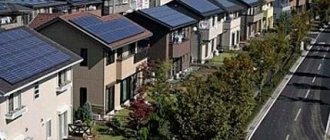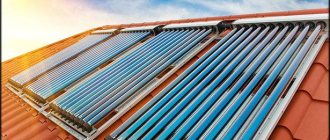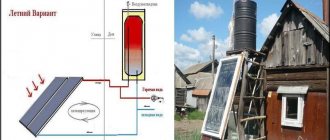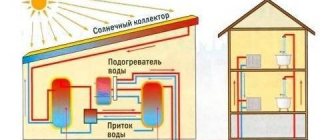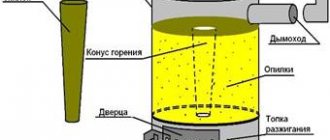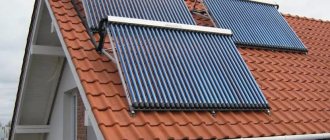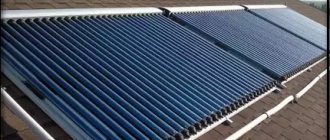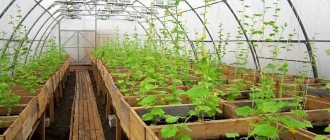Eco-friendly homestead: Heating a greenhouse can be organized in various ways. You can heat the greenhouse with electricity using heaters, infrared lamps, or an electric cable laid in the drainage of the greenhouse floor. You can heat the greenhouse with hot air. You can also build a combined heating system for a greenhouse, and combine various methods in such a way that the output is maximum and costs are minimal.
Surely no one is surprised now to see a wide variety of vegetables, fruits, and berries on store shelves and markets even in winter. Tomatoes, cucumbers, apples, pears, strawberries, cherries, watermelons, various exotic fruits - you can’t list everything. My eyes widen from this beauty, from all this abundance. But beauty is beauty, but the quality of all this, the environmental friendliness of the products often raise serious doubts. How it was grown, what it was fertilized with, how it was protected from pests - these questions are often impossible to answer.
Therefore, now you can see that the number of those who independently grow various plants in their summer cottage is increasing every day. Moreover, he grows it all year round, providing his family with environmentally friendly fresh vegetables and fruits. And with abundant harvests, the surplus is sold, bringing in some income.
Of course, it is impossible to grow vegetables and fruits outdoors all year round. For this purpose, greenhouses and greenhouses are built. Greenhouses are used only seasonally, usually in early spring, when seedlings are prepared to protect them from frost and bad weather. The greenhouse is used all year round, so in order to create favorable conditions for growing plants, care must be taken to ensure its heating.
Heating a greenhouse can be organized in various ways. You can heat the greenhouse with electricity using heaters, infrared lamps, or an electric cable laid in the drainage of the greenhouse floor. This is quite an expensive method. In addition to the cost of the equipment, you will also need to pay for the electricity spent on heating.
You can organize water heating by installing heating radiators in the greenhouse, or by laying pipes in the drainage through which heated water will circulate. You can heat the greenhouse with hot air. You can also build a combined heating system for a greenhouse, and combine various methods in such a way that the output is maximum and costs are minimal.
Laying pipes for water heating in the greenhouse floor
From the point of view of energy costs, the most economical option is to organize heating of the greenhouse using solar energy. Moreover, regardless of which heating method was chosen - air, water or combined. After all, the energy of the sun costs nothing, and what coolant will be heated by the solar collector matters to absolutely no one.
What's included in the system
Solar panels.
We wrote about how to collect them in this article (opens in a new window). You can buy a ready-made set of solar panels for your home, but to save money, you can purchase polycrystalline solar cells and assemble solar panels for your home with your own hands. Inverter. Solar panels produce direct current close to 12 or 24 volts (depending on the connection), the inverter converts it into alternating current 220 V and 50 Hz, from which all household appliances can be powered.
Battery. Even their system. Solar energy is not produced constantly. During peak hours there may be an excess of it, and with the onset of dusk its production stops altogether. Batteries accumulate electricity during daylight hours and release it in the evening/night. How to choose a battery for a solar power plant is written in this article (opens in a new window).
It is important to know. It is not recommended to use ordinary car batteries for these purposes - they become unusable after 2-3 years of operation (this is the service life they are designed for). Controller
Provides a full charge to the battery and protects it from overcharging and boiling. We wrote about which controller to choose in this article (opens in a new window)
Controller. Provides a full charge to the battery and protects it from overcharging and boiling. We wrote about which controller to choose in this article (opens in a new window).
Cost of installing solar panels
The approximate cost of one panel is 90 rubles per 1 W.
That is, one module with a maximum power of 200 W will cost you 18,000 rubles. It is clear that one such module is not enough for the normal functioning of all networks and communications at home. You'll have to buy more than ten of them. Your own solar power plant for your home with a total capacity of 1 kW will cost you approximately 250 thousand rubles. not counting the cost of installation and additional devices (inverter, batteries, charge controller). Solar batteries based on monocrystalline or polycrystalline silicon will ensure complete autonomy of your home from central power grids, both during warm periods and during frosts. The main thing is to choose the right photocells and calculate their required quantity, based on the area of the house and the required power. It would also be a good idea to take care of savings: replace light bulbs with energy-saving ones, insulate walls and roofs, install high-quality doors and window systems. Then your home will be warm and cozy, regardless of the weather.
Solar panel performance
Many people doubt the effective operation of these installations, because the weather in our country is not always sunny. And in winter, cloudy days are almost constant, and severe frosts contribute to the rapid waste of accumulated energy
Today's solar power plants are very powerful (from 200 W for one module). They produce energy all day long and capture light even in thick clouds or precipitation. True, in bad weather their power is reduced by almost half. Their advantage is that they are able to accumulate energy for future use. and if there is a lack of sunlight, they will give away what they have already accumulated.
In winter, the installations operate at full capacity, but their productivity is reduced due to the short daylight hours. A generation of batteries made from amorphous silicon don't even need to be pointed at the sun. They work great even in moderate clouds. The disadvantages of this type of modules include the fact that they require a large area for placement.
The effectiveness of their work depends on the region. For example, in St. Petersburg or Moscow, productivity will be slightly lower than in the southern regions. But this does not mean that their use in the northern regions is not advisable. Moreover, they have long been used there all year round and quite effectively.
Polycarbonate manifold
They are made from honeycomb panels with good thermal insulation properties. Sheet thickness from 4 to 30 mm. The choice of polycarbonate thickness depends on the required heat transfer. The thicker the sheet and the cells in it, the more water the installation can heat.
To make a solar system yourself, in particular a homemade solar water heater made of polycarbonate, you will need the following materials:
- two threaded rods;
- propylene corners, the fittings must have an external threaded connection;
- PVC plastic pipes: 2 pcs, length 1.5 m, diameter 32;
- 2 plugs.
The pipes are laid parallel to the housing. Connect to the hot water supply via shut-off valves. A thin cut is made along the pipe into which a sheet of polycarbonate can be inserted. Thanks to the thermosiphon principle, water will independently flow into the grooves (cells) of the sheet, heat up and go into the storage tank located at the top of the entire heating system. To seal and fix the sheets inserted into the pipe, thermally resistant silicone is used.
To increase the thermal efficiency of a cellular polycarbonate collector, the sheet is coated with any selective paint. Heating of water after applying selective coating accelerates approximately twice.
Greenhouse heat accumulator
Those who like to grow vegetables and fruits at any time of the year should understand and know that there are additional products, including a heat accumulator for greenhouses and greenhouses, thanks to which this activity becomes easier and brings real pleasure.
What is a greenhouse battery?
This is a unique, very useful energy storage device, but not one that everyone confidently uses in vehicles, boilers, as well as in many other devices that need to be provided with electricity for a certain period of time. This is a kind of device that can accumulate energy from the sun, and then distribute it to the right places.
Greenhouse heat accumulator: how it works
The heat accumulator for greenhouses has its own operating principle, which is simple and convenient.
If we are talking, for example, about a water accumulator, then it is necessary to pour plain water into one or another device, over time it is heated by the sun, and at night the heat accumulator for greenhouses gives off heat to the beds with plants, thereby providing them with heat and simplifying the process of growing zucchini and other vegetables and fruits in a greenhouse.
If you are wondering how a greenhouse heat accumulator works, then you should understand that there is nothing complicated in this process. The only factor to consider is that the device must be dark in color, because it is dark colors that attract the sun’s rays the most.
What types of greenhouse batteries are there?
Of course, among the most effective options that can be used to heat a greenhouse structure is a stove, as well as a certain heating part. But it is worth noting that not every person has the opportunity to use such devices, because the greenhouse may not be located near the house, or even far away in the country.
Thus, among the large number of products on the market, there are special ones that are made from black films about 250 microns thick. Water is poured into the product and it begins to work.
These are effective devices that can be easily placed on the beds in the required order and provide complete heating. In the daytime, such devices heat the air temperature to 25 degrees, when it’s even -5 below zero outside. This means that the seedlings will not be able to freeze.
Do-it-yourself heat accumulator for a greenhouse
You can make such a device yourself. In order to make a heat accumulator for a greenhouse with your own hands, you use only the means that are at hand.
The main requirement is that the product can independently collect water and also release it in conditions of low temperature. In such cases, no metal containers are used, since this material heats up very quickly and releases thermal elements only for a short time.
Thus, you can make a heat accumulator for a greenhouse with your own hands from the following materials:
Everyone has seen that in the summer, stones quickly gain temperature, and can release heat for a long time
That is why it is important to think about whether the selected device can store energy. As an example, let us note heating stoves that are made of steel, brick
By the way, the latter type takes a very long time to cool down.
It is important to understand that the larger the diameter, the better it will serve. Typically, you can find devices with a diameter of 50 and 100 mm
One side of such a product must be sealed, which will eliminate the risk of water leakage. Specialized stores sell special plugs of one diameter or another, with which the pipe is securely fastened.
The other one is also characterized by tightness, but you should not close it tightly, because it is in this side that you should pour water, and also control the liquid level. There are quite a lot of implementation options, including the use of simple plastic bottles.
Types of greenhouse batteries:
- Mermen
- Stone
- Ground
We have already talked about the water version, we also figured out the stones. Now let’s consider a situation where the soil can act as an energy accumulator.
This is the cheapest heating method, but it has a small effect and is significantly inferior to the two above methods.
The soil is characterized by low heat accumulation, so it is worth using one or another mechanical device for heating the greenhouse.
What does heat storage provide?
The operation of a greenhouse is based on the entry of solar energy into the shelter and its accumulation there due to the properties of the covering materials . However, even in winter, the amount of this energy far exceeds the needs of plants. The excess is simply reflected into space and does not bring any benefit from it.
If we use solar heat accumulation in a greenhouse , then the resulting reserves can then be successfully used for heating. The advantages are obvious : the temperature in the greenhouse is maintained at the desired level without consuming expensive energy resources for artificial heating.
Alternative heating sources and prospects for their development
Among the large number of different types of heating systems, alternative energy sources occupy a special place. In addition to traditional sources such as gas and electricity, all possible heating methods are used today. Among them are the following types of alternative energy sources:
- solid fuel – today, most heating systems use energy obtained from burning solid fuels such as wood and coal. Such systems are capable of solving all problems related to heating and hot water supply;
- a heat pump that uses the energy of soil and reservoirs is a very promising system that often requires large financial investments;
- wind generators that use wind power. In some countries where this issue is being addressed at the state level, such systems have great prospects and are already working quite effectively;
- solar panels powered, as you might guess, by solar energy. The design of such systems is usually of great interest. In some countries, such as Germany, solar panels provide heat and hot water to entire areas.
Solar heating system
Before imagining how the coolant is heated, it is worth considering what a solar battery is and what the principle of its operation is. A solar battery is nothing more than several photovoltaic converters combined into one unit, or a semiconductor device that uses sunlight and converts it into electricity. Everything happens in close connection with the basic laws of physics, which do not make much sense to consider. Today, solar energy attracts not only the views of scientists, but also ordinary people who are trying to solve problems related to water supply and heating.
Solar installations for hot water supply and heating systems
Solar collectors, which are used as a device for heating any liquid (most often water) for the purpose of using it in hot water supply or heating systems, have become very widespread and popular.
Another type of equipment for converting solar energy is batteries, which are fundamentally different from collectors in that they first generate and accumulate electrical energy, and later it can be used for household needs.
But this type of solar energy production and processing requires the purchase of expensive equipment, the main structural units of which are photovoltaic cells, which is not always justified, especially in regions with a small number of sunny days per year.
In contrast, solar collectors for heating water or heating a house have a quick payback, especially if you make them yourself, since in this case the costs will only be the cost of materials, which do not include expensive solar cells.
The use of solar collectors has obvious advantages:
- reduction of heating and water heating costs for the hot water supply system;
- environmental friendliness of this type of energy.
Most often, the use of collectors is justified for use in heating systems of small cottages or for organizing hot water supply in the summer in a country house or dacha. A solar collector for a swimming pool is justified as a device for heating water.
This is explained by the relatively low efficiency of such installations, which can decrease significantly on cloudy days.
Therefore, to optimize heating costs for a private home, it is best to use collectors in conjunction with traditional equipment, which can initially be designed for this, or has the ability to re-equip or coordinate the parallel operation of two heat supply systems.
It is also worth noting that, in addition to regular maintenance and cleaning the surface of the collectors from dirt and debris, some of them are not designed to operate at low temperatures, so before the start of winter they need to be preserved by first draining the coolant from the system.
DIY solar heating system
Today, the production of solar panels is already reaching an industrial level, but anyone can assemble a solar battery that can meet the needs of small house construction. Making solar panels with your own hands today is not much more difficult than assembling a simple electrical circuit. But for this you need to have everything you need, namely the solar energy converters themselves (monocrystalline solar cells), the necessary hardware, silicone sealant and soldering equipment. After this, you need to arm yourself with a soldering iron and get to work.
Before starting work, it is necessary to assemble the frame in which the solar cells will be located. It is a glazed box. For this purpose, you can order a metal-plastic double-glazed window made to the required size. Then we proceed directly to preparing the solar battery elements for assembly. To do this, contacts, or current-carrying tracks, are soldered to each of them. Then the system is assembled, consisting of four rows of nine elements in each row, for a total of 36 elements. The distance between assembly elements should be 5 mm.
During assembly, one condition must be observed - each adjacent row must be rotated 180 degrees, which will allow all elements to be assembled into one single chain. After this, it is necessary to attach a diode to each bundle consisting of six modules, although it is preferable to do this to each individual element. At the output, another common diode is installed, which is supplied complete with monocrystalline ones. After this, all contacts are finally bonded, and all voids are filled with silicone.
Upon completion of assembly, the internal surface is processed. To ensure the functionality of the device, you can cover the device with aluminum foil. Naturally, it is necessary to convert the received energy to obtain the required voltage. To do this, the solar energy is accumulated using a charging controller and the 12V battery is charged. After this, using a special inverter, this voltage can be converted into the required 220 Volts. As a result, 36 elements, 0.5 Volts each, ultimately allow us to obtain the required voltage.
However, hearing it is one thing, but seeing it with your own eyes is quite another. In this case, a lot of questions that usually arise after reading any material will immediately disappear. In the video presented, the process of assembling a solar battery seems very clear and intelligible. Many people can make a solar radiator if they have at least some skills in electrical engineering.
Solar vegetarian device
The uniqueness of this design is that it does not require additional heating for growing heat-loving plants, provided that the air temperature outside the greenhouse walls does not fall below -15 degrees. In regions with more severe frosts, the greenhouse is solar or not used in the coldest months, or heating is installed in it (see Heating a greenhouse with your own hands: workshop). This effect is achieved due to the features of the design itself and the air circulation system equipped in it, which will be discussed in more detail below. The same system allows you to do without ventilation, as well as reduce the frequency and intensity of watering.
Design features of the structure
At first glance, this is an ordinary greenhouse with a flat pitched roof, one of its sides is opaque or is the wall of a permanent structure to which the shelter is adjacent. But upon closer examination, the following features are revealed:
- The greenhouse is always located strictly in the north-south direction;
- It has a slope towards the south ranging from 15 to 40 degrees depending on the geographical latitude and the altitude of the sun in the winter months;
- The northern wall is always made capital; it serves as a light reflector and is therefore finished on the inside with foil or covered with white paint;
The foil coating reflects the rays into the greenhouse
The beds (see Beds in a greenhouse: how to arrange and arrange them to get a good harvest) are arranged in the form of steps, reinforced with high borders made of boards, bricks or other available material, with passages between them.
Photos of stepped beds
The walls of the greenhouse are also located not perpendicular to the ground, but at an angle. This reduces the reflection of the sun's rays, especially during the period from autumn to early spring - at low solstice, as a result of which more energy penetrates into it.
Air circulation system
The most interesting question is how can such a greenhouse manage without various heating systems during the cold season? After all, if you believe those who are already familiar with solar vegetarians, with night frosts of -15 degrees, the temperature in them does not drop below +12. This is quite enough to grow, if not tomatoes and cucumbers, then greens in a greenhouse all year round. The secret lies in the operation of the air exchange system. First, let's tell you how it works. Pipes with perforations along the bottom are laid under the entire area of the greenhouse at a depth of about 30 cm:
- The distance between the pipes is 50-60 cm;
- The pitch between the holes in the pipe is 10-15 cm;
- The diameter of the holes is 7-8 mm.
The pipes, like the entire surface, are located on a slope. Their lower ends, which serve as air intakes, are brought up so that they protrude above the soil surface and are covered with a fine mesh or grate to prevent debris from entering.
Air intakes protrude 15-20 cm above the surface
In the upper part they are combined into a common collector, from which a vertical pipe goes up in the thickness of the main wall, going out onto the roof of the vegetarian garden. It passes through a control chamber located one and a half meters from the surface, with an electric fan and two plugs - at the bottom and at the top.
As you can see, the instructions for setting up the system are extremely simple - you don’t have to do anything complicated. In addition, it must be said that it is better to use thin-walled pipes and lay them on a cushion of expanded clay 15-20 cm thick.
Air exchange system diagram
The price of such equipment is significantly lower than heating equipment; moreover, it does not require connection to expensive energy sources and will partially replace the irrigation system. Now the interesting part is how it works:
- During the day, the sun's rays warm the air and soil in the greenhouse. The temperature in it, even with negative values outside the shelter, reaches 18-20 degrees due to the correct location and design features.
- Fans force warm air into the pipes through air intakes. As it passes through them, it cools down, simultaneously releasing moisture that condenses on the inner walls. Through drainage holes in the bottom of the pipes, it flows onto the expanded clay layer and is evenly distributed in the soil under the beds.
- The cooled air returns to the greenhouse without losing the carbon dioxide and nitrogen that plants need for nutrition.
As a result, we have: maintaining temperature balance, air exchange without ventilation, autonomous drip irrigation and providing plants with nutrients without adding unnecessary fertilizers.
From all that has been said, it is clear that assembling a greenhouse of this type is profitable, especially if you want to use it in the cold season. All that remains is to find out how to do this.
Technical and electrical parameters of installations
- High resistance
- Efficiency from 20%
- Strained glass
- Water permeability of the case
- Resistance to bad weather conditions
Most often, an electrical system is used to heat a house that receives energy from solar modules.
But sometimes water heating is also carried out. which is supplied to the electric boiler. The heating circuit and installation in this case differ only in that additional space will be needed to accommodate batteries and a DC-DC converter. When using solar energy, it is more efficient to heat large areas (for example, heated floors) to small values. In such a system it is easier to change the temperature. if the weather changes, it’s easier to mount it. than others. In addition, the appearance of the interior will not be spoiled by bulky radiators.
For cars
For car owners, fans are also available that can be powered by a solar battery. These are low-power fans that are placed under the windshield of a car and serve to create additional circulation inside the cabin air.
The appearance of such devices can vary from the classic look of a fan to avant-garde forms inherent in the original works of developers and designers.
The advantage of this type of fan is that you can ventilate the car interior when the engine is turned off, without using the energy of the car battery, which will preserve its charge.
Water solar collectors for greenhouse heating
For a number of reasons, water heating of greenhouses is more preferable, although the cost of such a system is significantly higher than the cost of an air heating system. In essence, the solar water heating system of a greenhouse is no different from the solar heating system of a country house itself.
The differences lie only in the shape and location of the heating elements. In greenhouses, instead of the usual heating radiators for the room, pipes are laid along the walls in which warm water circulates. Pipes are also laid in the earthen floor of the greenhouse at a depth of 30 to 50 cm. This ensures both air heating and soil heating in the greenhouse.
Solar water heating diagram
In a water heating system, the coolant can be heated both in flat-plate collectors and in collectors on vacuum tubes. In a flat-plate collector, a flat coil is attached to the absorber, the manufacture of which requires a copper tube. This copper tube is first filled with salt, and only then can it be bent without fear of kinks.
When the tube takes the desired shape, the salt is easily washed out of it with running water. The coil is attached to the absorber and painted black with heat-resistant paint. The inlet and outlet pipes are brought out, and the holes through which they were brought out are sealed.
Scheme of a flat solar collector
Manifolds have a different design, built using vacuum tubes, which are connected with their tips to the coolant circuit pipe. Vacuum tubes are a glass cylinder, inside of which a copper tube with a low-boiling liquid is placed. The upper end of the copper tube is slightly expanded and sealed.
The space between the outer and outer tubes has been evacuated to create the maximum possible thermal insulation. The liquid inside the copper tube heats up and evaporates when exposed to solar radiation. Steam rises to the tip and heats it. Giving off heat, the steam cools, condenses and flows down the walls. At the tip the temperature can reach 270°C – 300°C.
Vacuum tube diagram
Vacuum manifold
The liquid heated in solar collectors is supplied by circulation pumps to a heat exchanger installed in the boiler. The water heated in the boiler enters the heating system. This tank must have strong thermal insulation to retain heat in the dark.
To prevent the water in the boiler from cooling too much, another heating element of the backup heating system is provided. This system turns on when necessary at night and can be powered from the home's solar power supply batteries.
Solar energy is increasingly becoming part of our everyday life. Its possibilities are inexhaustible. The sun gives us light, heat, electricity. And it would be simply unforgivable not to take advantage of this source of free energy. published econet.ru
Device and types
Conventionally, these systems can be classified into two types
:
- liquid (which we talk about in this material);
- air solar collectors, which use heated air rather than liquid.
They are also divided according to efficiency, because they provide different heat transfer. It depends on the materials used to make the battery and its area. The optimal location for the absorber is the roof
:
- receives the maximum amount of sunlight,
- has a large area
- The battery installed on the roof does not take up any useful space and does not interfere with anyone.
Air solar collector
The design of the solar collector can be of several types, the main
:
- vacuum heating manifold, which has the most complex design. Vacuum solar collectors are excellent for heating rooms, heating water at any time of the year, they will completely provide a small house or cottage;
- A flat solar collector can be liquid or vacuum. This is the most common type because it is quite easy to install, yet it is efficient and can provide the house with the necessary amount of heat for heating the premises, and water for household needs;
- thermosiphon - glass or metal tubes are used as an absorber;
- tubular - the simplest type that can be made for a summer residence; it is quite primitive and not suitable for use in winter.
We are interested in a design that ensures the availability of hot water and heating in the house at any time of the year; we will focus on two optimal options, consider the design of a vacuum solar collector and a flat one.
Flat-plate collector
This is the most common type of collector that you can make yourself. Well suited for use in the warm season for heating water; in winter the efficiency decreases.
The design feature is as follows
:
- the body has a flat rectangular or square shape, made of metal or other material with a high thermal conductivity, coated with black paint;
- inside there is a plate in which a coil made of a copper tube of small cross-section is laid;
- coolant circulates through the tubes: water, propylene glycol, antifreeze, and other suitable liquids;
- also, thermal insulation material is placed inside the housing, which minimizes heat loss;
- When assembling a collector of this type, you need to stock up on a sheet of polycarbonate or glass, which will serve as a cover and perform two functions: prevent the penetration of debris and precipitation, and enhance heating.
Component of a flat-plate solar collector
Vacuum manifold
For water heating, vacuum-type solar collectors can be used. Thanks to their design features, they are more powerful: they are able to generate thermal energy, which is enough to heat water and heat rooms.
Design Features
:
- Tubes that are placed in flasks with the air pumped out allow to minimize losses;
- the tubes are covered on top with an absorption material that absorbs light energy, and inside they are filled with antifreeze (refrigerant);
- the ends of the tubes are connected to a pipe through which the coolant passes;
- when heated, the antifreeze boils and turns into steam, which, in turn, rises and heats the coolant;
- This design has a drawback: if at least one tube fails, repair becomes quite problematic, since they are connected in series. All the “internals” will have to be replaced.
Airborne solar system made of vacuum tubes
Such an air-air solar collector for heating will be more efficient and suitable for maintaining the temperature in the system in any season. Although in cold weather, the efficiency of a working collector may decrease slightly due to short daylight hours and low light activity.
Care tip! Pay attention to the inner surface of the water storage tank; it becomes covered with scale over time and needs cleaning. Frequency depends on the water quality in the area
Where to begin
Calculation of electricity costs. To determine the required power of a solar panel system, you need to calculate how much electricity you use. Much in this matter depends on whether a private house is used constantly or only as a summer house in certain seasons of the year. To calculate, take electricity payment receipts for the year and determine the total number of kilowatts spent during this period, then divide by 12 (the number of months) - you will get the average monthly electricity consumption.
Calculation of average monthly electricity consumption
As experience and reviews from real consumers show, in central Russia the result must be multiplied by a factor of 16 to obtain the required battery power in Watts.
Let's look at an example. In a year you spent 1625 kW, divide this figure by 12 months and multiply by a factor of 16 - it turns out 2166 watts. Those. a solar panel system will provide such a house if its power is at least 2200 Watt/hour
Ideas for heating greenhouses with your own hands
Many summer residents install greenhouses or greenhouses on their plots to grow seedlings in them and get an earlier and richer harvest. But if such a structure is equipped with a heating system, then you can harvest vegetables, herbs and even strawberries all year round. But to make heating in a greenhouse, you will need preparation and some construction skills.
Methods of heating greenhouses
There are several types of heating for indoor structures for growing vegetables all year round. Each of them has its pros and cons.
Possible types of heating and their advantages:
- Stove heating is characterized by high efficiency, simple construction technology, availability of fuel and the ability to regulate temperature. Installing a furnace or boiler will not require large financial costs.
- Air heating can quickly heat any area, and its construction technology is quite simple.
- The water system is reliable, safe and temperature adjustable. When using such devices, the greenhouse will always have air humidity suitable for growing plants.
- Solar panels are a natural, affordable, simple and cheap heating process. On a sunny day, the heat transfer from them is gradual.
- Gas heating is practical, relatively low cost, and provides fast and uniform heating when using a heater.
- Electric heating of greenhouses and greenhouses is practical, simple and effective. The devices can be used around the clock, and portable equipment can be installed in any convenient place.
But each of these heating systems has its drawbacks. Among them:
- Stove heating requires constant monitoring.
- In an air system, the heating process must be constantly maintained.
- For water heating, you may need electrical equipment for heating water or even installing an entire boiler room. All this is not cheap.
- Solar panels are only effective in good sunny weather. When using them, it will not be possible to regulate the air temperature.
- The gas system requires constant monitoring as there is a risk of fire. To install it, permission from special services is required.
- Electrical equipment requires a power source, dries the air and is quite expensive to use (electricity costs).
A specific heating system is suitable for each building. For example, for standard greenhouses with a small area, you should not choose expensive equipment. And in large industrial greenhouses, infrared coolants, heat pumps and other advanced technologies can be used.
How to accumulate energy for a GREENHOUSE!
Reviews:
Mikolo Isidorovich Palyga
writes: SUPER OVEN Mikolo Palygi for heating the GREENHOUSE.
Ruslan Bulatov
writes: What is the total volume of the greenhouse and what is the total volume of the heat accumulator?
Mikolo Isidorovich Palyga
writes: SUPER OVEN Mikolo Palygi for heating the GREENHOUSE.
Ruslan Bulatov
writes: What is the total volume of the greenhouse and what is the total volume of the heat accumulator?
You can improve heating efficiency by installing a huge number of small closed aqua heat accumulators. They should be placed sparingly over the entire area of the greenhouse. This will allow them to warm up faster and, in the future, give off heat more moderately.
Heating of greenhouses with solar air collector
Such a collector is the main element of this heating system. Depending on the location of this collector, heating can be carried out either by natural air circulation in the system or by using fans.
In the first case, the outlet pipe of the manifold should be located below the socket of the inlet in the greenhouse. Then the air heated in the collector, according to the laws of convection, will rise through the air duct and enter the greenhouse. The displaced cooled air enters the collector through the return air duct, heats up and returns to the greenhouse. This cycle is continuous and lasts throughout the entire sunny day.
In the second case, the location of the solar collector does not matter, since air circulation is supported by fans installed in the greenhouse at the warm air inlet
This method ensures uniform distribution of warm air masses throughout the heated volume, and, what is very important, uniform heating of the soil
Naturally, air ducts (especially hot ones) must be covered with thermal insulation so that the air cannot cool down quickly. At night, the air in a greenhouse without hot feed can cool quite quickly. Therefore, to maintain thermal conditions, it is necessary to provide a backup heating circuit. These can be fan heaters, air heaters.
The airborne solar collector itself is an extremely simple design. You can assemble it yourself from scrap materials in less than an hour. This is a sealed wooden box 10–15 cm high. The bottom is made of fiberboard. For strength, the side walls are connected with wooden blocks with a section of 5x5 centimeters.
A heat insulator is placed on the bottom - polystyrene foam or mineral wool. An absorber, for example, galvanized iron sheet, is placed on top of the heat-insulating layer. To increase the heating area, additional fins can be attached to this sheet.
All seams on the inside of the box are carefully treated with “Sealant”, after which the inside of the box is coated with black heat-resistant paint. Depending on where and how the collector will be installed, pipes for air inlet and outlet are built into its sides. After all the preparatory work, the box is closed with tempered glass, the joints of the glass with the body are sealed with “Sealant”.
Solar air collector diagram
All that remains is to put the collector in place and connect the air ducts to the greenhouse. In this case, the outlet pipe of the collector should be located above the inlet pipe. The dimensions of the collector are determined only by the dimensions of the metal sheet and glass. Depending on the size of the greenhouse, there may be several such collectors.
The air in such a collector is heated to a temperature of 45°C - 50°C. The heated air not only maintains a comfortable temperature for plants in the greenhouse, but, giving off its heat, also heats the soil, which creates the most favorable conditions for the development of the plant root system.
how to make a ground heat accumulator
Alexey Shimko
writes: The heated floor, powered by a solar collector and an intermediate hydraulic heat accumulator, will be on a different floor level.
Alexey Shimko
writes: 70 cm.
Alexey Shimko
writes: Heat is not taken from under the foundation, but rather stored. There will be a fan at the roof ridge that will pump warm air into the battery and return the cooled air back under the roof.
Alexander Krymchak Vegetarian – Smart greenhouse
writes: cool topic, have you completed it? is the system working?
Valera Myachin
writes: How many years will it take for such a system to pay for itself?
“Lezheboka” is a long, dense, dark-colored polyethylene sleeve, on one side of which there is a hole with a screw-shaped notch, equipped with a screw-on cap. The length of the sleeve is 4 m, width – 21 cm. After filling with water, the width of the product will decrease to approximately 15 cm.
Water is poured inside through the hole, leaving a third of the sleeve empty. If possible, deflate the air, screw on the cap and place the sleeve in the aisle. It works independently: during the day, the black film absorbs heat and releases it to water; at night, the heat slowly returns to the atmosphere.
The principle of operation of solar panels
Modules that capture solar energy are electricity generators based on photovoltaic reactions.
Electric current is generated according to the principle of emission (emission of electrons) of heated bodies. The basis for the panels is silicon. The efficiency of one such module is not too high - about 30% with a power of up to 300 W. To obtain better results, the developers combined several dozen solar cells in circuits. And this method gave better results; some installations can fully operate even in moderate cloudiness. To create a comfortable temperature all year round in a house of 30 square meters. m. in the central zone of our country, the total surface area of the modules should be at least 100−120 sq. m. m. Inside the house there must be a room for batteries and distribution equipment.
